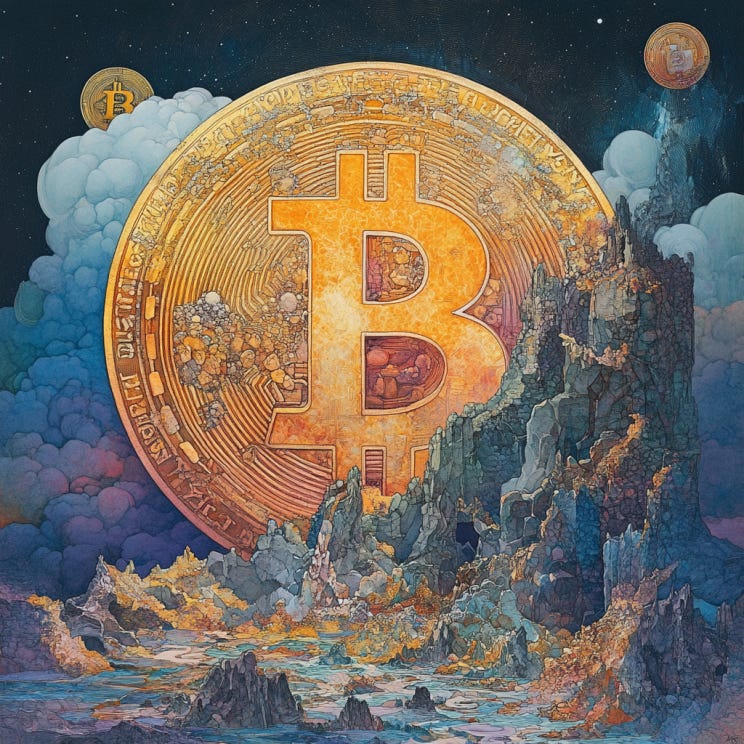Bitcoin vs. MVRV-Z Score
MVRV-Z score has been a historically reliable on-chain indicator of bull market tops and bear market bottoms
One of the most historically accurate markers for the Bitcoin “bull market top” (i.e. euphoric valuation range) and “bear market bottom” has been an on-chain indicator known as the “MVRV-Z Score.”
What is the MVRV-Z Score?
The MVRV Z-Score is a metric used to assess when Bitcoin is overvalued or undervalued relative to its “fair value.”
It is calculated as:
Where “Realized Value” is the aggregated cost basis of all coins in circulation (valued at the price when they last moved), and σ(Market Value) is the standard deviation of market value over time.
Historically, the MVRV Z-Score has shown a pattern:
High (e.g., ≥7-9): Often correlates with market cycle tops, suggesting extreme overvaluation.
Low (e.g., near or below 0): Often correlates with market cycle bottoms, suggesting undervaluation.
Predictive Power of MVRV-Z for BTC Market Cycle Tops

Historical Behavior:
2011 top, 2013 double-top, and 2017 peak all saw MVRV Z-Score entering the 7 to 9 range shortly before or around the market’s blow-off top.
For example, in late 2013 and late 2017, the metric spiked above 7, signaling a potential cyclical peak.
The 2021 peak also saw MVRV Z-Score approach similarly elevated readings, though the signal was somewhat less pronounced and more diffuse due to the nature of the year’s two distinct peaks (April and November 2021).
Strength:
The MVRV Z-Score has correctly signaled conditions near cycle tops in 3-4 major historical cycles since Bitcoin’s inception.
Historically, once the Z-Score moved sustainably above 7, the market was nearing a euphoric, overextended condition.
Limitations:
The exact threshold for “overvalued” can vary as the market matures and volatility reduces. Historically used thresholds (e.g. >7) may shift over time.
Tops can form over weeks, and MVRV Z-Score may not pinpoint the exact day or week of the peak.
As market structure evolves and institutional participation grows, historical correlations might weaken.
Predictive Efficacy (%):
If we define “efficacy” as how often the MVRV Z-Score’s high readings (above ~7) coincided with or were closely followed by a multi-month cyclical top, historical compliance has been quite strong.
Arguably around 70-80% efficacy for MVRV-Z in signaling an impending cycle top, given it has not frequently given false positives at those extreme levels.
However, this is retrospective and not guaranteed moving forward.
Predictive Power for BTC Market Cycle Bottoms
Historical Behavior:
Post-2011 crash, 2015 bear market low, the late 2018/early 2019 low, and the March 2020 “Black Thursday” event saw MVRV Z-Scores near or below zero.
In these periods, a negative or near-zero Z-Score often aligned with deeply undervalued conditions and long-term accumulation opportunities.
Strength:
The MVRV Z-Score has historically highlighted deeply discounted price levels.
Investors who accumulated during these low or negative Z-Score readings were, in retrospect, buying at or near bear market floors that preceded multi-year bullish runs.
Limitations:
While low MVRV Z-Score often aligns with undervaluation, it does not guarantee an immediate bottom. Markets can remain undervalued for extended periods.
Macro conditions, liquidity crises, or unprecedented external shocks might cause the metric to remain low longer than in past cycles.
Predictive Efficacy (%):
Historically, the bottom signals have also been strong—arguably 60-80% efficacy in highlighting accumulation zones that precede major growth phases.
As with tops, this is a retrospective measure.
MVRV-Z in Isolation: Confidence in Predicting Bitcoin Cycle Tops or Bottoms
Strengths When Used Alone:
Straightforward visual gauge of relative valuation.
Historically consistent at identifying regions of extreme market sentiment (euphoria or depression).
Weaknesses When Used Alone:
May produce early or delayed signals, especially if market conditions differ from previous cycles.
Does not incorporate external factors such as macroeconomic conditions, regulatory changes, or industry-specific shocks.
Subject to diminishing returns as more participants anticipate and act on these signals, potentially dampening its edge.
Overall Confidence as a Sole Indicator (%):
Relying on MVRV Z-Score alone for high-stakes decisions might yield a moderate confidence level.
Perhaps around 50-60% if considered in isolation as a timing tool.
It’s more accurate at identifying broad zones (over/undervaluation) rather than exact turning points.
How accurate is MVRV-Z when combined with other indicators?
Using the MVRV Z-Score alongside:
On-chain metrics (e.g., HODL Waves, SOPR, Reserve Risk)
Market structure indicators (e.g., 200-week moving average, realized price)
Macro signals (e.g., interest rates, S&P correlations)
Can significantly improve overall predictive accuracy.
Confirmations from multiple independent metrics reduces the likelihood of false signals.
(Related: Bitcoin Bull Market Top Checklist)
Enhanced Predictive Power (%):
When integrated with a suite of on-chain and technical indicators, the probability of correctly identifying a market cycle top or bottom can rise to 70-85%, depending on the chosen combination.
For instance, if MVRV Z-Score is high and simultaneously other macro on-chain indicators flash red, confidence that a top is near increases significantly.
Similarly, if MVRV is low and other accumulation indicators suggest a historically attractive buying range, the conviction in a bottom call grows.
Overall:
For Tops: Historically consistent at highlighting euphoric peaks, around 70-80% accuracy in major cycles, but vulnerable to evolving market dynamics.
For Bottoms: Good at identifying undervalued conditions and long-term buying opportunities, around 60-80% historical efficacy.
As a Sole Tool: Useful guideline, moderate standalone confidence (~50-60%).
Combined with Other Tools: Significantly improved reliability (~70-85%), providing stronger conviction in signals.
General MVRV-Z Ranges vs. BTC Market Cycles
Below is a rough framework of how MVRV-Z Score ranges have historically corresponded to different stages of Bitcoin’s market cycle, along with indicative odds and confidence levels when relying solely on this metric.
Note that these figures are approximate, based on historical precedents, and should not be treated as guarantees.
Market conditions evolve over time, and these ranges are most effective as broad guidelines rather than precision tools.
1. Deep Undervaluation / Capitulation Stage
Range: MVRV-Z < -1
Historical Context: Past bear cycle lows often occurred in or near negative MVRV-Z territory. This range suggests that the market value is significantly below the aggregated realized cost basis—coins are changing hands at depressed prices.
Indicative Cycle Stage: Likely late bear market or bottom formation phase.
Approximate Odds: 70-80% probability that the market is bottoming or in a deep-value accumulation zone.
Confidence Level (MVRV-Z Only): Moderately High. Historically reliable in marking or closely preceding long-term lows.
2. Undervaluation / Accumulation Stage
Range: -1 ≤ MVRV-Z < 0
Historical Context: Prices are still relatively cheap compared to realized value, but not extremely so. This zone often represents early accumulation phases as long-term holders begin to steadily buy from weaker hands.
Indicative Cycle Stage: Early to mid-accumulation phase in a bear-to-bull transition.
Approximate Odds: 60-70% probability that the market is transitioning out of a bear phase and setting a foundation for future growth.
Confidence Level (MVRV-Z Only): Moderate. While often a good long-term entry zone, it can last for months, making exact timing challenging.
3. Fair Value / Neutral Ground
Range: 0 ≤ MVRV-Z < 1
Historical Context: Prices align closely with the realized value, suggesting a relatively stable, “fair” valuation. The market often finds equilibrium here either during mid-cycle plateaus or just before volatility returns.
Indicative Cycle Stage: Middle stage of the cycle, no clear direction—could be mid-bull consolidation or mid-bear stabilization.
Approximate Odds: ~50% probability of being in a stable, neutral environment, as this zone doesn’t strongly favor either top or bottom formation.
Confidence Level (MVRV-Z Only): Moderate-Low. Less decisive signal, can represent a lull before either a renewed uptrend or a deeper correction.
4. Modest Overvaluation / Early Overheated Conditions
Range: 1 ≤ MVRV-Z < 3
Historical Context: The market is trading above the aggregated cost basis by a noticeable margin, indicating some degree of optimism. However, it is not yet in the extreme euphoric territory.
Indicative Cycle Stage: Potentially mid-to-late bull run phase, but still with room to grow before hitting a cycle top.
Approximate Odds: 50-60% probability that the market is in a growing or maturing bull cycle.
Confidence Level (MVRV-Z Only): Moderate. This range indicates positive momentum but doesn’t guarantee a top is imminent.
5. Overheating / Late Bull Conditions
Range: 3 ≤ MVRV-Z < 7
Historical Context: Historically, these elevated scores coincide with increasingly speculative and euphoric market conditions, often preceding final legs of a bull run. While not as extreme as the top range, it suggests caution.
Indicative Cycle Stage: Late-stage bull market.
Approximate Odds: 60-70% probability that the cycle is in a mature bull phase, nearing eventual top territory.
Confidence Level (MVRV-Z Only): Moderate-High. Suggests a heightened risk of correction if sustained for a prolonged period.
6. Extreme Overvaluation / Euphoria Stage
Range: MVRV-Z ≥ 7
Historical Context: Historically, MVRV-Z scores above 7 have aligned closely with major cycle tops (2011, 2013, 2017). These are often periods of mania and FOMO buying.
Indicative Cycle Stage: Likely at or near a cyclical top.
Approximate Odds: 70-80% probability that the market is topping out or is extremely overvalued relative to realized value.
Confidence Level (MVRV-Z Only): High. Historically one of the most reliable signals for identifying overheated market conditions that precede substantial corrections.
Confidence Using MVRV-Z Alone:
Capitulation/Bottom Zones (<0): Moderately High confidence that you are near a bottom (60-80% range).
Neutral/Fair Value (0 to 1): Moderate-Low confidence due to ambiguous positioning (around 50%).
Overheated/Top Zones (>3): Moderately High to High confidence of late-stage or topping conditions (60-80%).
Note: These odds and confidence levels are not a promise of future outcomes, but rather a reflection of past market tendencies. Using MVRV-Z alone for market timing reduces overall confidence. Additional indicators—both on-chain and macro—can increase certainty and refine these probabilities.
Specific MVRV-Z Scores vs. Market Cycle Stage
Below are narrower MVRV-Z Score ranges, their typical market implications, and approximate odds of being in that stage based on historical data (for illustrative purposes only):
< -1:
Stage: Deep capitulation, likely near cycle bottoms.
Odds (~70-80%): High chance that a bottoming process is underway.
Confidence: Moderately high when used alone.
-1 to 0:
Stage: Undervaluation/Accumulation zone.
Odds (~60-70%): Market transitioning out of a bear phase, good long-term buying area.
Confidence: Moderate.
0 to 1:
Stage: Fair value, mid-cycle equilibrium.
Odds (~50%): Ambiguous phase; could precede either recovery or further decline.
Confidence: Moderate-low.
1 to 2:
Stage: Early optimism, mild uptrend forming.
Odds (~50-60%): Likely in a developing bull phase, but not guaranteed.
Confidence: Moderate.
2 to 3:
Stage: Bull market gaining strength, heading toward maturity.
Odds (~60-70%): Late bull but not at final peak yet.
Confidence: Moderate-high.
3 to 5:
Stage: Overheated conditions, elevated speculation.
Odds (~60-70%): Approaching or in a late-stage bull run.
Confidence: Moderately high.
5 to 7:
Stage: Extreme speculation, near top conditions.
Odds (~70-80%): Very likely in final euphoric phase of the cycle.
Confidence: High.
>7:
Stage: Euphoria & likely cycle peak.
Odds (~70-80%): Strong historical alignment with market tops.
Confidence: High.
Note: Once again, these odds and confidence levels are based on historical patterns, not future guarantees. They are best used as guidelines, not as sole decision-making tools.
Limitations of MVRV-Z Scores
It is important to understand the limitations of MVRV-Z scores in trying to gauge whether BTC is near a market cycle high or low.
is a detailed breakdown addressing the key limitations, historical accuracy, and projected reliability of the MVRV-Z Score as a Bitcoin market indicator:
Evolving Market Structure: Bitcoin’s market structure in 2011–2017 was primarily retail-driven and highly speculative, which made metrics like MVRV-Z particularly sensitive and useful. As institutional involvement grows, liquidity increases, and derivatives markets expand, past behavior may not translate perfectly into future patterns.
Threshold Sensitivity: The often-cited “critical levels” (e.g., Z > 7 for tops, Z < 0 for bottoms) are somewhat subjective and historically derived. As the asset matures, volatility diminishes, and Bitcoin’s realized and market values become more stable, these thresholds may shift. In other words, what once qualified as a “top zone” may not align with future market regimes.
Lagging and Non-Instantaneous: MVRV-Z does not necessarily pinpoint exact tops or bottoms. It often provides a general zone of over/undervaluation that can persist for weeks or even months. Using it as a precise timing tool can lead to premature exits or entries.
Lack of External Context: MVRV-Z is purely on-chain/value-based. It does not incorporate macroeconomic factors (e.g., interest rates, geopolitical events) or market sentiment from off-chain sources. These external factors can dramatically influence market direction independent of on-chain valuation metrics.
Diminishing Predictive Edge as Awareness Grows: As more traders and investors become aware of MVRV-Z and make decisions based on it, its predictive power might diminish. Markets tend to “front-run” well-known indicators, reducing their edge over time.
Historical Accuracy of MVRV-Z to Present (2024)
Historically, MVRV-Z Score has shown strong correlations with major turning points:
Market Tops (e.g., 2011, 2013, 2017, 2021): High MVRV-Z (≥7) often aligned closely with euphoric peaks. Historically, the odds of identifying a zone near the top when MVRV-Z was above 7 was around 70-80% in retrospect.
Market Bottoms (e.g., 2011-12, 2015, 2018-19, 2020): When MVRV-Z was below 0, it often indicated undervaluation and long-term buying opportunities. Again, historically about 60-80% efficacy in identifying bottoming regions.
Projected Reliability of MVRV-Z for Bitcoin’s Future
It is challenging to precisely quantify the reliability of any indicator decades ahead, given the changing market landscape.
However, we can offer some reasoned estimates based on trends:
2025-2030:
By this period, Bitcoin may see broader institutional adoption but still retain significant volatility and cyclical behavior. MVRV-Z may still capture fundamental psychological and cost-basis dynamics.
Projected Reliability: Moderately High. Perhaps a 60-70% chance it remains a helpful broad-cycle indicator, though less likely to perfectly match historical threshold performances as the market matures.
2030-2035:
Further maturation of the Bitcoin market could mean reduced volatility and more stable investor bases. With less dramatic boom-bust cycles, the extremes highlighted by MVRV-Z might be less frequent and less pronounced.
Projected Reliability: Moderate. Possibly around 50-60% that it remains a valuable cyclical gauge. It may still signal relative undervaluation or overvaluation, but the amplitude and clarity of signals may diminish.
2035-2040:
If Bitcoin transitions into a more stable “digital reserve” asset class with widespread adoption, its price may move less dramatically around realized value. The MVRV-Z Score could trend closer to a neutral range for longer periods, reducing its utility as a cycle indicator.
Projected Reliability: Moderate-Low. Perhaps around 40-50% that MVRV-Z remains a strong independent predictor of major tops and bottoms. It may still provide signals but with reduced potency, especially if the market becomes more efficient and less speculative.
Historical vs. Future:
Historically, MVRV-Z has been fairly accurate (60-80% range) in highlighting top and bottom zones.
Over the next 5-15 years, as Bitcoin’s market potentially matures and stabilizes, the reliability of MVRV-Z as a cycle-top/bottom predictor may gradually decrease, possibly settling in a more modest 40-60% effectiveness range without adjustment or supplementation by other metrics.
Adapting thresholds, combining MVRV-Z with other on-chain indicators, and incorporating macro context will likely remain crucial for maintaining a high degree of reliability in the future.
Is MVRV-Z Score the most accurate on-chain indicator for macro highs & lows?
On-Chain Indicators Comparison:
When it comes to identifying macro-level buy and sell points for Bitcoin, MVRV-Z is often considered one of the stronger on-chain tools due to its historical ability to highlight major cyclical tops and bottoms.
While it’s not flawless, it stands out for its blend of market value, realized value, and historical volatility.
Yet, there are a few other on-chain indicators that analysts sometimes argue rival or complement MVRV-Z:
RHODL Ratio:
Strength: Historically pinpointed cycle tops with high accuracy, capturing the euphoric peaks as long-term holders distribute coins to newer, price-insensitive buyers.
Limitation: Less intuitive for bottoms and may be slower to signal extended accumulation phases.
Puell Multiple:
Strength: Good at identifying periods when miner revenue (in USD) is extremely high or low, often aligning with overheated conditions (potential tops) or miner capitulation events (potential bottoms).
Limitation: More miner-focused and may be influenced by changing mining industry dynamics over time.
Reserve Risk:
Strength: Measures the risk/reward of long-term holders selling into strength. It has historically flagged excellent buying opportunities (low risk) and periods of high risk (potential tops).
Limitation: Not as widely cited for exact top signals as MVRV-Z and may evolve as holder behavior changes.
In practice, each of these contenders excels at certain aspects but falls short in others.
MVRV-Z is relatively balanced at signaling both ends of the market cycle, whereas the alternatives tend to be stronger on one side (tops or bottoms) rather than both.
Does any on-chain metric beat MVRV-Z as a top/bottom signal for Bitcoin?
No single on-chain metric has conclusively and consistently “beaten” MVRV-Z in accuracy for both tops and bottoms combined.
Some metrics may be slightly better at calling tops (e.g., RHODL Ratio) or bottoms (e.g., Reserve Risk), but MVRV-Z remains one of the most holistic, historically tested indicators.
This doesn’t mean it will always perform best in the future, but given the known data, MVRV-Z is one of the top contenders if you must choose a single on-chain tool.
Off-Chain Indicators:
Off-chain metrics—such as macroeconomic indicators (interest rates, GDP growth), equity market correlations (S&P 500 trends), or global liquidity measures—tend not to provide as direct or as historically consistent signals for Bitcoin’s cyclical tops and bottoms as MVRV-Z has done.
While macro factors can influence BTC price significantly, they are not as reliably timed or as specifically tied to BTC’s internal valuation structure.
Thus, no single off-chain indicator currently demonstrates a track record that surpasses MVRV-Z for timing major buy/sell points over multiple Bitcoin cycles.
MVRV-Z as the best single metric for BTC cycle tracking?
If forced to pick just one indicator for identifying long-term optimal buy/sell regions, MVRV-Z would be a strong candidate - at least in the near term.
It has a solid historical track record, is relatively well-understood, and provides intuitive valuation extremes.
While its future effectiveness is not guaranteed, it has no single, clearly superior rival among on-chain metrics.
Similarly, off-chain indicators, while sometimes helpful as a backdrop, have not historically offered the same cycle-specific timing accuracy that MVRV-Z and its close peers have demonstrated.
Is MVRV-Z a Leading or Lagging Indicator?
MVRV-Z is generally considered a leading indicator, as it has historically signaled market tops and bottoms ahead of major price movements (weeks to months).
Since it is calculated using real-time market value and the slower-moving realized value, this creates a stabilizing effect, reducing sensitivity to short-term noise.
While not prone to sudden, extreme swings unless driven by significant price changes, MVRV-Z dynamically reflects market conditions.
It does not "lag" like traditional indicators such as moving averages, making it a valuable tool for anticipating trends rather than reacting to them.
Tracking Daily vs. Weekly vs. Monthly MVRV-Z as a Signal: Which is Best?
Some wonder whether tracking daily MVRV-Z is better than weekly avg. MVRV-Z or monthly avg. MVRV-Z.
Although daily MVRV-Z can be a bit noisy due to volatility, I think daily MVRV-Z is helpful for determining cycle top zones (they tend to be shorter-lived) and weekly or monthly MVRV-Z averages are better for identifying cycle bottoms (or at least historically this has been the case).
Daily vs. Weekly vs. Monthly MVRV-Z Averages
Daily MVRV-Z: Provides the most immediate reading, capturing market dynamics as they change. However, daily readings can be a bit noisy due to short-term volatility.
Weekly or Monthly Averages: Smoothing over longer periods (e.g., a 7-day or 30-day moving average of MVRV-Z) can help filter out noise and offer a clearer, more stable signal. This approach might slightly delay your recognition of turning points, but it reduces false positives.
Identifying Top and Bottom Zones
1. Top Identification (~MVRV-Z ≥ 7):
Historically, sustained readings above 7 have aligned closely with market cycle peaks. Instead of reacting the moment MVRV-Z hits 7, consider waiting for it to remain elevated for several days or even a couple of weeks. This confirmation can help avoid reacting to brief spikes.
Another strategy: Use a short moving average of MVRV-Z (e.g., a 7-day average). If the 7-day average remains above 7 for more than a week, that’s a stronger signal you’re in a top zone.
2. Bottom Identification (~MVRV-Z ≤ 0):
When MVRV-Z dips below zero, it suggests undervaluation and potential bottom formation. Just as with tops, waiting for sustained low readings (e.g., remaining below zero for a week or more) can help filter out transient dips.
Consider layering in other indicators or looking for consistent negative readings before acting. For example, if MVRV-Z averages below zero for a full month, that strongly indicates a high-value accumulation zone.
Narrowing Down to ~10% of the Turn
To get within roughly 10% accuracy of major turning points:
Use thresholds as zones rather than triggers. For example, treat MVRV-Z ≥ 6 as your early warning zone for tops. Once it crosses 7 and stays there, prepare to scale out over time, rather than selling all at once.
Similarly, for bottoms, begin accumulating BTC when MVRV-Z dips below 1 and continues downward, adding more aggressively once it goes below 0 and stays there.
Best Practices
Combine Levels with Time-Confirmation: Don’t rely on a single day’s reading. Look for MVRV-Z to remain above or below critical thresholds for several consecutive days or weeks.
Use a Smoothed Version: A 7-day or 30-day moving average of MVRV-Z helps avoid knee-jerk reactions.
Be Flexible: Treat the identified zones as areas rather than exact price points. MVRV-Z might hover around a top or bottom range for weeks. This patience can help ensure you catch the turning zone even if you don’t nail the exact day.
Contextualize with Other Signals: While MVRV-Z is powerful, combining it with other on-chain metrics or technical indicators can refine your timing and confidence even further.
In Short: MVRV-Z is not inherently a lagging indicator that will jump drastically due to data delay.
Using it with smoothing, time confirmation, and threshold zones is the most reliable approach.
Daily readings are fine for monitoring, but weekly or monthly averages help confirm true top and bottom formations.
By doing so, you can often identify turning points within about ±10% of the cycle extremes.
Using an MVRV-Z-only strategy for Bitcoin (BTC) buys/sells? (Hypothetical Scenario)
Below is a detailed, hypothetical MVRV-Z-based strategy for maximizing long-term returns.
This is not financial advice, but a conceptual framework illustrating how one might use MVRV-Z for strategic BTC accumulation and distribution in a high-stakes scenario.
Core Objective:
Buy heavily during historically undervalued periods (MVRV-Z < 0) and gradually accumulate as it remains low.
Sell heavily during historically overvalued periods (MVRV-Z ≥ 7) and scale out as the score stays elevated.
Entry (Buying) Strategy:
1. Define Bottom Accumulation Zones:
Accumulation Trigger: Begin accumulating BTC in a steady, systematic manner once MVRV-Z falls below 1. This signals you’re entering a relatively low-risk environment.
More Aggressive Buying: If MVRV-Z drops below 0 and stays there for at least 7 consecutive days, become aggressive—buy larger amounts. Historically, these conditions have often marked deep undervaluation.
Sustained Low Readings: If MVRV-Z hovers below 0 for a month or more, treat this period as prime accumulation time. Add to positions regularly. The longer it stays undervalued, the more confident you can be that you’re building a substantial position near a long-term bottom.
2. Timing for Bottom Proximity (~10% Accuracy):
Don’t expect to catch the absolute bottom. Instead, focus on building a heavy position throughout this undervalued zone. The goal is to own a substantial amount of BTC by the time MVRV-Z returns toward positive territory.
Once MVRV-Z climbs back toward 1, reduce the pace of buying. By now, you should have built a solid position near historically favorable price levels.
Exit (Selling) Strategy:
1. Define Top Distribution Zones:
Early Warning: When MVRV-Z crosses above 5 or 6, treat this as a caution zone. Start planning your exit strategy.
Primary Sell Trigger: Once MVRV-Z hits 7, assume you are in a euphoric market environment. Begin selling a significant portion of your holdings, ideally 20-30% of your position. Don’t wait for it to just “touch” 7—wait for it to hold above 7 for at least a few days to confirm sustained overvaluation.
2. Scaling Out:
If MVRV-Z stays above 7 for a week or more, continue selling in increments. For example:
Above 7 for 7 days: Sell an additional 20%
Stays elevated (7+) for another week: Sell another 20%
Continue this incremental exit until you’ve offloaded the majority (70-90%) of your position. Historically, sustaining MVRV-Z >7 for an extended period has been rare, and this environment is where tops have formed.
3. Refinement for Top Proximity (~10% Accuracy):
You won’t pinpoint the exact top, but by distributing your BTC as MVRV-Z remains in the extreme zone, you increase the odds of capturing prices near the peak.
If MVRV-Z starts dropping sharply from high levels (e.g., falls below 5 after being above 7), exit most of the remaining position. A sharp retreat from these extremes often signals the end of the euphoric phase.
Risk Management & Time Confirmation:
Time-Based Confirmation: Use a 7-day moving average of MVRV-Z to avoid knee-jerk reactions to single-day spikes. For instance, only begin selling aggressively after the 7-day average of MVRV-Z surpasses 7.
Don’t React to One-Day Flukes: If MVRV-Z briefly hits 7 and then the next day falls back to 6, give it a few days to confirm a trend. The same applies to the downside: MVRV-Z dipping below 0 for a single day doesn’t guarantee a bottom—wait for sustained undervaluation.
Adjusting for Changing Market Conditions:
Willingness to Adapt: If future markets prove less volatile, consider lowering the top trigger from 7 to, say, 6.5 or 6, based on evolving historic averages. For bottoms, if the metric rarely goes negative in a mature market, consider 0.5 or 0 thresholds as substitutes.
Combine With Basic Market Sentiment: Check if extraordinary macro events coincide with extreme MVRV-Z readings. For instance, if a huge regulatory clampdown occurs when MVRV-Z is low, you might extend the accumulation phase.
High-stakes MVRV-Z-only strategy:
Buy Low: Heavily accumulate when MVRV-Z <0, continue buying as long as it stays depressed.
Sell High: Systematically offload large portions of BTC once MVRV-Z ≥7 and stays elevated.
Use Time and Averages: Smooth out entries/exits by waiting for multi-day or multi-week confirmations, and possibly use a short moving average to filter noise.
Accept Imperfection: The goal isn’t to nail the exact top or bottom, but to trade in the historically proven zones where MVRV-Z suggests the best odds.
This approach gives you a disciplined, historically informed framework to maximize returns from BTC cycles using MVRV-Z alone in a high-stakes scenario.
What are the odds that MVRV-Z Score remains reliable from 2025-2030?
Based on historical patterns and the trajectory of market maturity, a reasonable estimate might be in the range of 60-70% odds that the outlined MVRV-Z-based strategy will still perform effectively between 2025 and 2030.
Here's the rationale:
Historically Derived Confidence: From 2011 through 2021, MVRV-Z effectively highlighted major cycle tops and bottoms. While past performance isn’t a guarantee of future results, the multi-cycle track record gives it a solid baseline.
Market Maturation: By 2025–2030, Bitcoin’s market may have matured further, increasing liquidity and potentially reducing extreme volatility. While this could diminish the amplitude of MVRV-Z signals, the general pattern of undervaluation and overvaluation relative to realized value is likely to persist, albeit with possibly slightly softer extremes.
Behavioral Consistency: Investor psychology—fear at the bottom, greed at the top—will probably remain consistent. MVRV-Z, being based on aggregated cost basis and market value, indirectly tracks this psychology. Even if signals become subtler, the metric should still help identify broad accumulation and distribution zones.
Adaptive Thresholds & Confirmation Methods: If users adapt thresholds or incorporate time confirmation (e.g., waiting for sustained periods above/below certain levels) as suggested, the approach can remain robust. Such adjustments improve odds that the strategy remains relevant as conditions evolve.
While no single indicator or strategy is guaranteed to work indefinitely, the MVRV-Z-based approach described likely retains a 60-70% probability of continued success for identifying broad buying and selling zones throughout the 2025–2030 timeframe.
Placing Higher Weight on Highs & Lows – Less on Mid-Range MVRV-Z…
The strength of MVRV-Z lies in its ability to highlight extremes—the zones where the market is historically most overvalued or undervalued relative to realized value.
High MVRV-Z (e.g., ≥7): Historically correlated with tops, or at least times when the market is overheated and due for a correction. This is where MVRV-Z has been most accurate in signaling major sell zones.
Low MVRV-Z (e.g., ≤0): Often marks periods of deep undervaluation and has been linked to bottoming processes or accumulation phases that precede the next major upward cycle. It’s a reliable guide for long-term entry opportunities.
Mid-Range MVRV-Z (e.g., around 1-3): These readings represent more neutral territory. In these zones, Bitcoin’s market price and realized value are not significantly out of line. The market could move in either direction, making the signal less decisive and potentially less useful as a timing tool.
It’s smart to put greater emphasis on extreme MVRV-Z readings—both high and low—and treat mid-level readings with more caution.
The extremes provide clearer historical guidance for buying and selling decisions.
MVRV-Z Score Compression with BTC Market Cap Increases (Expectations)
As Bitcoin’s market cap increases and the asset becomes more liquid, widely held, and less speculative, we should expect the MVRV-Z Score’s extreme bounds to compress.
Historically, in Bitcoin’s early, low-market-cap days, MVRV-Z reached double digits at cycle tops and dipped well below zero at bottoms.
As the market has matured into the trillion-dollar range, we’ve observed lower peak MVRV-Z values (e.g., struggling to surpass 7 in recent cycles) and more moderate bottoms (often hovering near, but not necessarily far below, zero).
This means MVRV-Z could become less reliable/accurate as a signal of BTC market cycles - because market cycles may become extremely subtle (e.g. cycle tops 2-3 and bottoms ~1).
1. Greater Liquidity & Broader Distribution
A larger market cap generally means more participants, more diverse holder bases, and less price sensitivity at the margin.
In an early, small market, a surge of new buyers can inflate the market price far above the realized value, creating huge MVRV-Z peaks.
Conversely, panic-selling can push prices well below realized value, generating deeply negative MVRV-Z readings.
As market cap grows, these extreme psychological swings tend to be muted because:
It’s harder for the market to become wildly over- or undervalued due to the sheer capital required.
More stable long-term holders and institutional participants may reduce extremes in behavior.
2. Narrowing Variance Between Market and Realized Value
Realized value (aggregate cost basis) will likely track closer to market value over time as more coins are held by long-term investors with relatively stable cost bases.
This closer relationship reduces the potential for huge divergences that push MVRV-Z to extreme highs or lows.
Hypothesized Future Thresholds by Market Cap Levels:
(These are speculative, illustrating a possible pattern rather than precise predictions.)
Below $1T Market Cap (Past/Early Cycles):
Tops: Often >7, even 9-10+
Bottoms: Well below 0, often -1 or lower
Explanation: High speculation, low liquidity, small holder base.
$1T–$5T Market Cap Range (Current & Near Future):
Tops: Around 5–7
Bottoms: Around 0 to slightly negative (-0.5 to 0 range)
Explanation: More stable than early cycles, but still room for speculation-driven extremes.
$5T–$10T Market Cap Range (Moderate Maturity):
Tops: Perhaps 4–5
Bottoms: Near 0, rarely dipping negative
Explanation: Greater liquidity and institutional presence reduce wild swings. Overvaluation and undervaluation zones narrow as realized value tracks more closely with market price.
$10T–$15T Market Cap Range (High Maturity):
Tops: Possibly 3–4
Bottoms: Slightly above 0 (0.5–1 range)
Explanation: With Bitcoin established as a major asset class, huge spikes in speculative mania become less common. The market behaves more like a large, liquid commodity or a store-of-value asset.
$15T–$20T Market Cap and Beyond (Very High Maturity):
Tops: Possibly 2–3
Bottoms: Around 1 (never truly “undervalued” by past standards)
Explanation: At this scale, Bitcoin’s volatility and speculative fervor may resemble that of a mature commodity like gold. MVRV-Z would likely oscillate in a narrower band, as major participants constantly rebalance and price-in fundamentals more efficiently.
Changing Strategies & Recalibration:
As these extremes narrow, the old thresholds (e.g., selling only above MVRV-Z of 7 or buying only below 0) may lose effectiveness.
Traders and investors would need to recalibrate what constitutes “overvalued” or “undervalued” in a larger, more stable market.
Over time, a MVRV-Z of 3 might be considered a cycle top in a $20T market, whereas historically it would have looked relatively tame.
Latency and Behavior:
As the amplitude of MVRV-Z swings reduces, the clear-cut “blow-off” tops and “capitulation” bottoms may also diminish.
Instead of rapid spikes followed by abrupt crashes, future cycles might see more subtle, drawn-out topping and bottoming processes.
This would require more nuanced interpretation and might push traders to rely on additional indicators or more sensitive thresholds calibrated to the new market environment.
Increasing BTC Market Caps vs. MVRV-Z:
Expect lower peak MVRV-Z levels and less negative lows as market cap grows.
Thresholds that worked in a $1T market environment may be too high or low for a $10T or $20T environment.
A future $10T+ market likely demands a new scale, where a top might be considered at MVRV-Z ~3 or 4 instead of 7 or 10, and bottoms might hover around or just above 1 instead of dipping below zero.
Predicted MVRV-Z Peak for the 2024-2025/2026 Bitcoin Cycle
Given the historical trend of diminishing MVRV-Z extremes and a maturing Bitcoin market, it’s reasonable to predict that the MVRV-Z peak in the 2024 cycle may not surpass the highest historical levels (e.g. 9-10 from early cycles).
The 2021 cycle already showed somewhat lower peaks, generally topping out just over 7 (only 2 days above 7: Feb 19, 2021 & Feb 21, 2021).
Keep reading with a 7-day free trial
Subscribe to ASAP Drew to keep reading this post and get 7 days of free access to the full post archives.



















